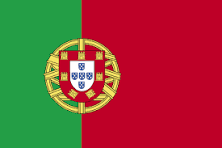Portuguese flag Colors Code hex, png svg
The flag of Portugal has a rich history and significant symbolism in its colors and design. Here’s a detailed explanation:
History
- Early Designs (12th – 16th Century):
- The earliest flags of Portugal were simple designs featuring the cross of the Order of Christ, reflecting the country’s strong religious ties during the Reconquista period.
- Kingdom of Portugal (12th – 19th Century):
- Various changes occurred over the centuries, mainly featuring the royal coat of arms. The flag’s design evolved to represent the growing influence and territories of the Portuguese Empire.
- Republican Revolution (1910):
- The current flag was adopted on June 30, 1911, following the Republican Revolution of 1910, which ended the Portuguese monarchy and established the First Portuguese Republic.
Design and Colors
The current flag consists of two vertical bands: green on the hoist side and red on the fly side, with the national coat of arms where the colors meet.
- Green:
- Symbolism: Represents hope and the Portuguese Revolution of 1910.
- Historical Background: Though initially controversial, green was chosen to symbolize the new republic and break away from the traditional royal blue.
- Red:
- Symbolism: Represents the blood of those who died defending the nation, as well as the struggle and sacrifice of the Portuguese people.
- Historical Background: Red has historically been associated with the republican movement and the revolutionary spirit.
- Coat of Arms:
- The Shield: Central to the coat of arms is a complex shield that includes:
- Five small blue shields: Each with five white dots arranged in a cross, representing the five Moorish kings defeated by Portugal’s first king, Afonso I, and symbolizing divine protection.
- Red border with seven castles: Representing the extension of Portuguese territory and the country’s historical role as a defender of Christianity.
- The Armillary Sphere: Behind the shield is a golden armillary sphere, a navigational instrument symbolizing Portugal’s maritime exploration and discoveries during the Age of Exploration.
- Green and red field: The shield is placed over the boundary where the green and red fields meet, symbolizing the unity of the republic.
Interpretation
The flag’s design and colors encapsulate Portugal’s historical journey from a monarchy to a republic, its maritime heritage, and the enduring spirit and resilience of its people.
Guess the Flags Quiz
Sharing is caring 🤗

National Symbols 👇
- 🏁 National Flags
- 🦁 National Animals
- 🐦 National Birds
- 🌻 National Flowers
- 🌴 National Trees
- 🥭 National Fruits
- 🍹 National Drinks
- 👴 National Founders
- ☘️ National Emblems
- 🍲 National Dishes
- 🏛️ National Monuments
- ✍️ National Poets
- 🕌 National Mausoleums
- 🎺 National Instruments
- 🦸 National Heroes
- 📆 National Days

